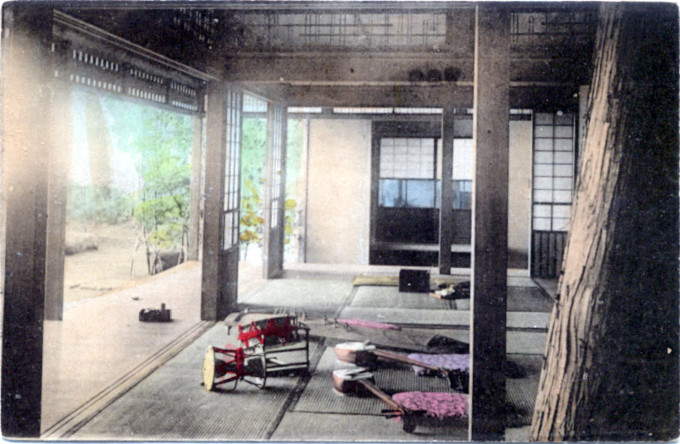See also:
Tea picking at Uji, c. 1920
Tea time, c. 1910
Green tea culture, c. 1950
“Historically based on the refined aesthetic of the tea ceremony, the ochaya embodies the best of traditional Japanese architecture and interior design. Each room must have a tatami floor and a tokonoma [alcove] replete with the appropriate monthly scroll and a suitable arrangement of flowers in a suitable vase. These amenities are completely changed for each customer.
“At some point the geiko [artistic geisha] perform. There are basically two kinds of geiko, a tachikata and a jikata. A tachikata is a main performer. She is trained to dance and play an instrument other than the shamisen, such as the flute or the hand drum. A jikata is an accompanist who is trained to play the shamisen and sing.”
– Geisha: A Life, Mineko Iwasaki, 2003
From the wiki: “In Japan, an ocha-ya (literally. ‘tea-house’) is an establishment where patrons are entertained by geisha. Ochaya, where geisha entertain, should be distinguished from okiya [boarding house], where geisha live. Though the term ochay means ‘tea house’, they do not serve tea, except incidentally (as an ordinary beverage); buildings or rooms for Japanese tea ceremony are instead known as chashitsu (literally, ‘tea room’). Ochaya are typically very exclusive establishments – with very rare exceptions, one may only enter if one is an established patron, or accompanied by a patron, with reservations.
“Relationships to ochaya can often be traced back generations, and are generally associated with a family or company. Switching ochaya is not generally possible, and even patronizing ochaya other than the one with which one is associated is considered a very serious breach of manners. Ochaya cater to a discreet clientele, and thus do not present a particularly conspicuous front, but nor are they particularly secretive as to their location. Ochaya are generally located on or near the main streets of their geisha district, and will generally have the name at the entrance, with an entrance curtain (noren) and front garden in larger houses.”



Pingback: Tea time, c. 1910. | Old Tokyo
Pingback: Tea picking at Uji, c. 1920. | Old Tokyo